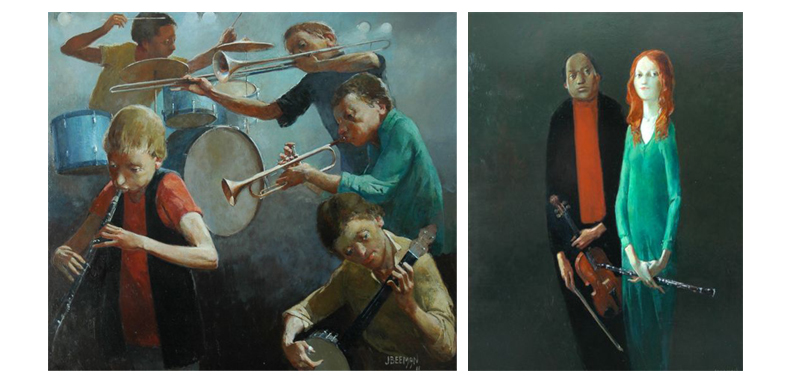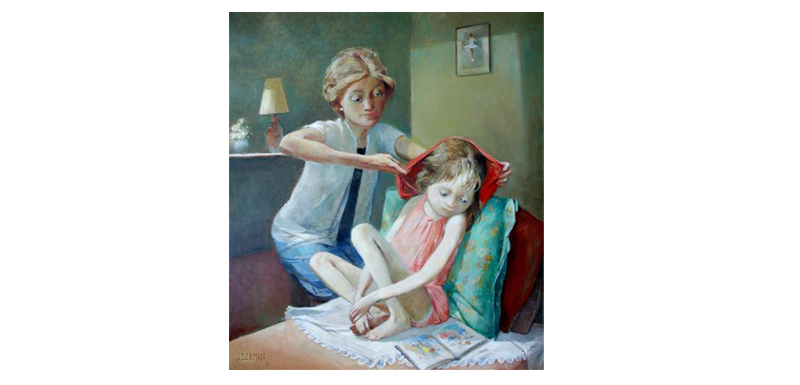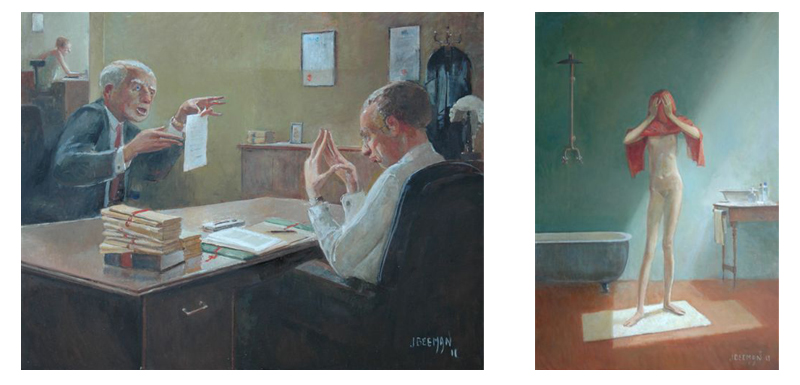Welcome to the second in our series of blog interviews. This month we chat to master artist John Beeman whose next exhibition will be at Red Hill Gallery in May 2012. A John Beeman exhibition creates an atmosphere charged with excitement, Beeman collectors wait patiently for his next exhibition, wanting regular updates from gallery staff, there is a fear they will miss out! This popularity of John’s work has lead to sell out exhibitions and those lucky enough to own a Beeman, tend to keep his work forever refusing to part with it. Johns work is admired by art lovers and collectors everywhere, each and every piece unique and depicts scenes from everyday life. His work is so skillfully mastered one has to wonder how long it takes to complete a painting, each brush stroke purposefully placed, the subjects although every day demand to be noticed and understood. A snap shot in the life. Here is a peek into the man who creates these unique paintings.

This work is part of the upcoming John Beeman Exhibition at Red Hill Gallery in 2012 "The Band" 72 x 62 & "Duo" 44 x 82
AC: What inspires you to create?
JB: A situation between people that embodies communication, the quality of light, beautiful and interesting people and to quote William Blake:-
“To see the world in a grain of sand,
Heaven in a wild flower,
Hold infinity in the palm of your hand,
Eternity in an hour.”
AC: In three words describe your art
JB: Traditional figurative painting.
AC: How do you spend your leisure time?
JB: Painting or low level exisitence.
AC: Share something with us about yourself that we don’t know
JB: At the age of eighteen and nineteen I spent many long hours in the isolation of a gun turret of a B24 Liberator Bomber. Life expectancy of an air gunner was short and this precarious future led me to engage in some serious self-examination. I formed a philosophy of life and firm values that I have maintained.
AC: What music are you listening to (While you create?)
JB: Medieval to Modern classical music including composers such as Mozart, Brahms, Beethoven Chopin etc.
AC: What is your favourite time of the day?
JB: I like the quality of light in the early morning and late afternoon.
AC: In your biography it states that you studied at the Prestigious Julian Ashton Art School, do you have any memories that you would like to share with us from that time.
JB: Immediately Post War many of my fellow students, like myself, were ex-servicemen and women. They were trying that bit harder to make up for lost time. It was a period of endeavour, learning to see, enlightenment and other aspirations with like-minded students and great teachers.
The Julian Ashton Art School, the unique Sydney Art School, is a famous institution with an unparalleled background in fine drawing and painting.

This work is part of the upcoming John Beeman Exhibition at Red Hill Gallery in 2012 "Concentration" 63 x 71
AC: You use an age old method which was used by artisans as far back as the Renaissance era? Describe this technique.
JB: A SIMPLIFIED EXPLANATION OF GESSO – AS A GROUND FOR PAINTING
Apart from painting on walls, artists have been very limited in their choice of surface on which to paint.
There are two main surfaces which have remained unchanged for several hundred years. These are: – a fabric, usually canvas, stretched on a timber frame or a wooden panel. Both have to be coated with a primer, usually a white paint or gesso. Both of these have the added advantage of being portable. Each of the above have disadvantages as follows: – The flexible nature of the canvas has the potential to crack the paint surface and it is vulnerable to cuts and bumps and humidity and unstable atmosphere can have a harmful effect
on the painting.
Timber panels are limited in size, subject to warping and splitting and attacks by insects (borer and woodworm.)
Modern technology has produced materials that are dimensionally and chemically stable and can be obtained in large sheets. They suffer few of the disadvantages of canvas or timber.
During the years that I was doing my Post Graduate Studies in London at the Slade School of Fine Art. I was aware that while I was receiving a thorough grounding in the skills of drawing and painting, the information on painting materials was superficial and largely dependent on the range of choices in the art material suppliers.
I applied for one of the few positions at the prestigious Courtauld Institute. I was fortunate to be accepted, with three other like-minded students, to be trained in their laboratories in the chemistry and structure of painting. A further stroke of luck was at that time a Dutch conservator was working at the Courtauld Institute restoring a Flemish Painting for the National Gallery. He was an expert in the preparation of gesso and was keen to share his knowledge.
On returning to Australia I made gesso in the ‘time-honoured’ method, preparing the gesso with rabbit skin glue and calcium carbonate. There were five or six coats brushed on with a large flat brush, each at right angles to the last. The temperature of the gesso mixture had to be maintained within critical limits, allowed to set but not dry. In all
there were sixteen steps and it was very time consuming.
I continued preparing gessos this way until my son David developed equipment which was capable of applying the hot mixture while maintaining the critical temperature and viscosity.
The structure of the surface is all one could wish for and is physically and chemically stable.
The white gesso has great optical qualities reflecting the light back through paint layers. It is rugged and stands a certain degree of aggressive technique or a sensitive response to a fine application of glazes.
As well as oils these gessos can also be used for egg tempera or acrylic.
– John Beeman






